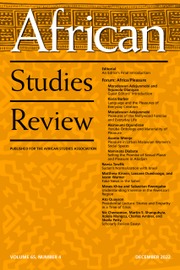The seminal work of Radcliffe-Brown and Evans-Pritchard focused on “simpler societies.” In doing so, they and the anthropologists who followed them intentionally averted their gaze from the modern political institutions of the state, thus ceding the topic to political scientists who were at times purveyors of abstract “macroanalysis” (7). But by the 1990s, some anthropologists had begun to train their eyes on the modern African state, and this volume deepens this line of inquiry by reporting data from contributors’ ethnographic fieldwork, mostly conducted between 2000 and 2019. Contributors want to understand the everyday experience of modern democracy and the state through qualitative descriptions of African citizens’ interactions with one another and with the impersonal institutions that increasingly shape their lives, an approach they call a “quotidian turn” (9). Ethnography is “a mode of knowing that privileges experience [focusing on] realms of the social that are not easily accessible within the more formal protocols used by many other disciplines” (3).
Authors write thematic case studies for eleven countries (South Sudan, Nigeria, Kenya, Chad, South Africa, Democratic Republic of Congo, Cameroon, Mozambique, Ethiopia, Burkina Faso, and Rwanda) that have cumulative national populations of about 720 million. Contributors are junior, mid-career, and senior scholars based in North America (n = 9), Europe (n = 7), and Africa (n = 3). Seven of fifteen chapters deal with rural areas, some quite remote. The book might be of interest to Africanists, country experts, anthropologists, and comparative political scientists.
Several topics are highly relevant for democracy, and the depth and quality of the no-doubt arduous fieldwork (estimated time in field sites in parentheses below) are impressive. According to political science theory, democracies inherently possess procedural legitimacy, but they still need performance legitimacy (Samuel P. Huntington, The Third Wave [University of Oklahoma Press, 1993], 48–57), and the latter is sometimes missing in the African countries of this volume. For instance, in urban Jos, Nigeria, the government struggled to provide reliable electricity, water, petrol, telephone, and transportation services, and some citizens remembered halcyon days when things were better. Ignominiously, generators imported from China provided a crutch for large sections of the ailing electricity grid. A picture shows a preacher’s face illuminated by the Bible app he read on his cell phone during a blackout (143, seventeen years).
On balance, the case studies convey the complexity and countervailing tendencies in the public institutions described. In rural Mozambique, locals saw the rural-based Renamo opposition party and fighting force as a legitimate bulwark against the urban-based, hegemonic Frelimo and thus conceived of “democracy” in “a conventional and globalized understanding of the word only slightly adapted to Mozambican reference points” (312, six months). In remote Maiduguri and Borno state, Nigeria, the Civilian Joint Task Force, or yan gora, or kato da gora (in Hausa, youth with sticks) vigilantes fought Boko Haram (231, six months). In Juba, South Sudan, citizens strove to get national ID cards, and the overwhelmed, nascent state bureaucracy was a composite of military ethnic loyalists and civilians (Ch. 1, twelve months). In DRC, the international Catholic church helped create an urban school in Lubumbashi, while locals in semirural Kasungami maintained control of their school (Ch. 14). In Burkina Faso, a semi-abandoned rural health post was a sign of the “absent-present” state (388, four months). Other topics include national liberal democracy civics curriculum viewed through the eyes of teachers who teach it in Ethiopia; car thieves’ interaction with police in South Africa (twenty-two months); rehabilitation centers for at-risk young men in Rwanda (thirteen months); police checkpoints in separatist Anglophone Cameroon (eighteen months); Somalis in the rural Dagahaley refugee camp in Kenya (twelve months); international nongovernmental organizations in very remote Biliqo and Isiolo, Kenya; and public perceptions of surveillance cameras from Laurent Kabila’s government in DRC.
The data generated by these scholars’ substantial fieldwork is enough alone to recommend this volume, but there is at least one area of potential improvement. Authors sometimes lack engagement with concepts that political scientists use to study the state and democracy. For instance, nowhere does Weber’s canonical definition of the state as a human community with a monopoly of legitimate force in a given territory appear, even just to clarify what some authors seem to disagree with. Similarly, political scientists have a rich theoretical framework to make sense of corruption, such as that seen in the visa process in the now-razed Oluwole urban market in Lagos (81). Authors present such corruption as self-evident variation from Weberian “rationality” (19); however, corruption, defined as use of public resources for private gain, is in fact an expected biproduct of modernization. According to Huntington, corruption has both cons and pros, as it throws a temporary bridge between traditional and modern institutions in a dynamic social context. “In terms of economic growth, the only thing worse than a [changing] society with a rigid, overcentralized, dishonest bureaucracy is one with a rigid, overcentralized, honest bureaucracy” (Political Order in Changing Societies [Yale University Press, 1968], 69). While political scientists’ concepts might help organize and make more meaningful the jumble of observations from authors’ fieldwork, the “critical theory of the state” (406) that one contributor calls for is less convincing as this perspective sometimes leads authors to fight with the very data they report.


